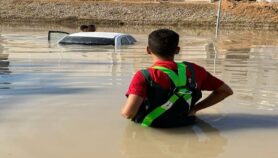By: Tharaka Gamage
Send to a friend
The details you provide on this page will not be used to send unsolicited email, and will not be sold to a 3rd party. See privacy policy.
[COLOMBO] A major malaria-spreading mosquito can breed in salty waters too, which has major implications for malaria control management in the country’s coastal areas, research from tsunami-hit areas of Sri Lanka shows.
Previous studies of the mosquito Anopheles culicifacies, the main carrier of parasite Plasmodium vivax that causes the milder and non-fatal malaria and P.falciparum that causes the fatal cerebral malaria, in Sri Lanka showed that it bred only in fresh water.
Malaria control authorities, therefore, also assumed minimal risks due to salt water intrusion caused by the December 2004 Asian tsunami that devastated Sri Lanka coasts.
New research from the University of Jaffna and Eastern University of Sri Lanka, funded by Sri Lanka’s National Science Foundation, shows that the mosquito breeds in salty waters too, which calls for changes in the country’s malaria control strategy. The findings are published in the Malaria Journal this month (21 April).
"Malaria [incidence] is low in Sri Lanka. Now the government should focus on brackish waters too to improve the efficiency of the malaria control programme," Sinnathamby urendran, senior zoology lecturer at Jaffna University and of the authors of the report, told SciDev.Net.
"Global warming may contribute to malaria transmission in coastal areas in many countries, by providing breeding grounds for salt-tolerant mosquitoes as the salinity of the water bodies increases," he added.
Surendran and his colleagues conducted their study near Batticaloa town in Sri Lanka’s eastern province which was hit by the 2004 Asian tsunami that left behind large pools of brackish water inland.
The team collected 935 larvae twice a month from September 2009 to February 2010, from both dry and wet seasons. More than two-thirds of them turned out to be A. culicifacies larvae, while the remaining were larvae of Anopheles subpictus and other species that breed in brackish water, but do not play a major role in disease transmission.
The team found that A. culicifacies could tolerate salinity changes over the monsoonal period from late November 2009 to end January 2010 and also water with salinity levels as high as four parts per thousand.
References
Malaria Journal doi:10.1186/1475-2875-9-106 (2010)













